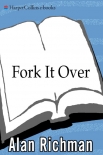Fork It Over The Intrepid Adventures of a Professional Eater-Mantesh Unknown (books to read for 13 year olds .txt) 📖

- Author: Unknown
Book online «Fork It Over The Intrepid Adventures of a Professional Eater-Mantesh Unknown (books to read for 13 year olds .txt) 📖». Author Unknown
No other country has a table the equal of France’s, and no chef in France is as acclaimed as Bocuse. Here, at his own school, unbeknownst to his staff, I plan to investigate the mysteries of French food. I will peel away the veils of secrecy much as Bocuse peels away the layers of an oignon.
I will try to discover why the French are so different from us, why they are concerned only with pleasure, never with nourishment. Why is it, I have been wondering, that people in other countries gather together whatever meager provisions they can find in order to feed their families, 4 6
A L A N R I C H M A N
whereas the French gather up their families in order to feed them at restaurants?
I will endeavor to learn how the French manage to eat so well in times of war or natural disaster—although I’ve heard that during famines they skip the petits fours. Why do Americans require Hamburger Helper to get by, while every Frenchman is entitled to a daily helping of steak tartare? I will attempt to find out why the French are guiltless where food is concerned. They believe eating veal is immoral only when it is tough.
I have five days to learn all of this, five days in a course called “Cuisine and Culture for French Food Lovers,” something I definitely was until my last trip to Paris, when none of my meals was any good. The course costs about $1,000, and consists of cooking lessons and demonstrations that start a 9:00 a.m. each day and go on until 4:30 or 5:00 p.m.
We are promised a chance to work on more than a dozen recipes in kitchens that gleam like Napoleon’s cavalry. We will observe top-notch professionals preparing classics, the kinds of dishes once reserved for noblemen in velvet pants. For an additional $250, we can even sleep on campus, although those lured to the school by photos of the headquarters, a lush nineteenth-century château, should be forewarned: the residence hall has aqua walls and yellow doors and looks as though it belongs on the campus of a cash-starved Sunbelt junior college. My class numbers about a dozen, all but one of us American, and includes an oboe player, a housewife, and a honeymooning couple who have taken advantage of the housing offer and are sleeping in twin beds.
My classmates and I are issued lab coats and funny little paper chef’s hats that must be stapled together before they are worn. The school’s hats look like galvanized stovepipes and denote status within the food community: the taller the hat, the more important the chef. Our instructor, Chef Antoine Fremont, is a Big Hat. His assistant, Hélène Rebour-seau, a first-year student in a two-year course, wears a hat only half as big.
Our first recipe is salmon medallions in a Beaujolais sauce with bone marrow and grapes. As you can tell, we have already crossed the line that separates what the Lyonnaise consider good eatin’ from what everybody F O R K I T O V E R
4 7
else considers good eatin’. Chef Antoine asks if anyone has any questions before we begin. One student asks if he could have another staple in his hat. Chef Antoine does not look pleased.
Lesson number one is how to blanch onions. Lesson number two is how to blanch salt pork. Already my mission is a success, for I have learned about this odd French addiction to blanching, a cooking technique that consists of plunging the ingredient in question into boiling water while exclaiming, “Voilà!”
When they are not blanching, the French seem always to be deglaz-ing. This is a fancy word for removing the cruddy stuff that sticks to the bottom of a roasting pan. Voilà! The cruddy stuff is the basis for all those rich sauces Americans pay so much for in restaurants, not realizing what they are made from. The French so admire the cruddy stuff that they even have a name for it, “le suc.” I’m not saying that American chefs don’t deglaze, but you’ve got to admit that giving the cruddy stuff its very own name demonstrates an unnatural degree of affection.
As we proceed with the salmon recipe, I learn all of the following: how to remove pits from whole grapes using a paper clip (a process not much different from removing wax from your ear using a paper clip), how to pop near-frozen marrow from a bone so it comes out in one conical piece (a really disgusting procedure you don’t want to know about), and how to make lardons. This last is an eye-opener. When Americans dine at cute little French bistros, they often order salads with lardons, thinking they’re getting something moderately healthy, a bunch of frizzy greens with a few chunks of bacon tossed in. Those chunks of bacon are lardons, cubes of pork fried in butter. The French really like fatty food fried in butter, especially if the fatty food is blanched first.
For our next dish, Chef Antoine instructs us in the preparation of salmon cutlets wrapped in smoked bacon. I raise my hand and ask Chef Antoine if the French feel cheated if they do not have pork with their fish. Chef Antoine does not look pleased. He tells us how to wrap a cutlet: encircle the salmon with a strip of bacon (much as a filet mignon is wrapped in American restaurants





Comments (0)